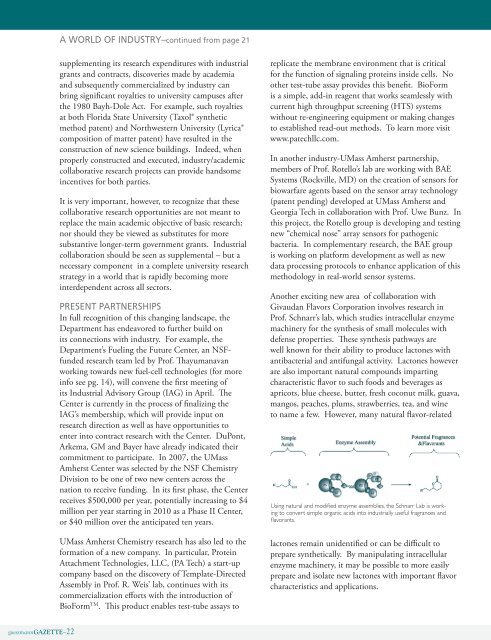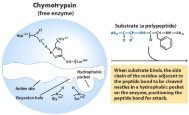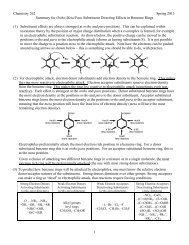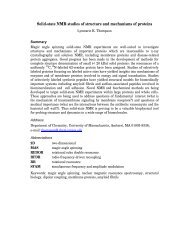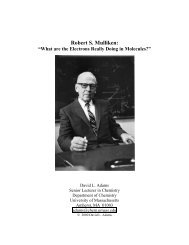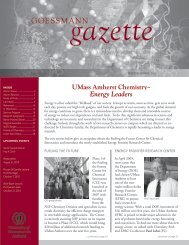goessmann - Department of Chemistry-University of Massachusetts ...
goessmann - Department of Chemistry-University of Massachusetts ...
goessmann - Department of Chemistry-University of Massachusetts ...
Create successful ePaper yourself
Turn your PDF publications into a flip-book with our unique Google optimized e-Paper software.
<strong>goessmann</strong>GAzETTE–22<br />
a WORLd OF INduSTRy–continued from page 21<br />
supplementing its research expenditures with industrial<br />
grants and contracts, discoveries made by academia<br />
and subsequently commercialized by industry can<br />
bring significant royalties to university campuses after<br />
the 1980 Bayh-Dole Act. For example, such royalties<br />
at both Florida State <strong>University</strong> (Taxol® synthetic<br />
method patent) and Northwestern <strong>University</strong> (Lyrica®<br />
composition <strong>of</strong> matter patent) have resulted in the<br />
construction <strong>of</strong> new science buildings. Indeed, when<br />
properly constructed and executed, industry/academic<br />
collaborative research projects can provide handsome<br />
incentives for both parties.<br />
It is very important, however, to recognize that these<br />
collaborative research opportunities are not meant to<br />
replace the main academic objective <strong>of</strong> basic research;<br />
nor should they be viewed as substitutes for more<br />
substantive longer-term government grants. Industrial<br />
collaboration should be seen as supplemental – but a<br />
necessary component in a complete university research<br />
strategy in a world that is rapidly becoming more<br />
interdependent across all sectors.<br />
PRESENT PaRTNERSHIPS<br />
In full recognition <strong>of</strong> this changing landscape, the<br />
<strong>Department</strong> has endeavored to further build on<br />
its connections with industry. For example, the<br />
<strong>Department</strong>’s Fueling the Future Center, an NSFfunded<br />
research team led by Pr<strong>of</strong>. Thayumanavan<br />
working towards new fuel-cell technologies (for more<br />
info see pg. 14), will convene the first meeting <strong>of</strong><br />
its Industrial Advisory Group (IAG) in April. The<br />
Center is currently in the process <strong>of</strong> finalizing the<br />
IAG’s membership, which will provide input on<br />
research direction as well as have opportunities to<br />
enter into contract research with the Center. DuPont,<br />
Arkema, GM and Bayer have already indicated their<br />
commitment to participate. In 2007, the UMass<br />
Amherst Center was selected by the NSF <strong>Chemistry</strong><br />
Division to be one <strong>of</strong> two new centers across the<br />
nation to receive funding. In its first phase, the Center<br />
receives $500,000 per year, potentially increasing to $4<br />
million per year starting in 2010 as a Phase II Center,<br />
or $40 million over the anticipated ten years.<br />
UMass Amherst <strong>Chemistry</strong> research has also led to the<br />
formation <strong>of</strong> a new company. In particular, Protein<br />
Attachment Technologies, LLC, (PA Tech) a start-up<br />
company based on the discovery <strong>of</strong> Template-Directed<br />
Assembly in Pr<strong>of</strong>. R. Weis’ lab, continues with its<br />
commercialization efforts with the introduction <strong>of</strong><br />
BioForm TM . This product enables test-tube assays to<br />
replicate the membrane environment that is critical<br />
for the function <strong>of</strong> signaling proteins inside cells. No<br />
other test-tube assay provides this benefit. BioForm<br />
is a simple, add-in reagent that works seamlessly with<br />
current high throughput screening (HTS) systems<br />
without re-engineering equipment or making changes<br />
to established read-out methods. To learn more visit<br />
www.patechllc.com.<br />
In another industry-UMass Amherst partnership,<br />
members <strong>of</strong> Pr<strong>of</strong>. Rotello’s lab are working with BAE<br />
Systems (Rockville, MD) on the creation <strong>of</strong> sensors for<br />
biowarfare agents based on the sensor array technology<br />
(patent pending) developed at UMass Amherst and<br />
Georgia Tech in collaboration with Pr<strong>of</strong>. Uwe Bunz. In<br />
this project, the Rotello group is developing and testing<br />
new “chemical nose” array sensors for pathogenic<br />
bacteria. In complementary research, the BAE group<br />
is working on platform development as well as new<br />
data processing protocols to enhance application <strong>of</strong> this<br />
methodology in real-world sensor systems.<br />
Another exciting new area <strong>of</strong> collaboration with<br />
Givaudan Flavors Corporation involves research in<br />
Pr<strong>of</strong>. Schnarr’s lab, which studies intracellular enzyme<br />
machinery for the synthesis <strong>of</strong> small molecules with<br />
defense properties. These synthesis pathways are<br />
well known for their ability to produce lactones with<br />
antibacterial and antifungal activity. Lactones however<br />
are also important natural compounds imparting<br />
characteristic flavor to such foods and beverages as<br />
apricots, blue cheese, butter, fresh coconut milk, guava,<br />
mangos, peaches, plums, strawberries, tea, and wine<br />
to name a few. However, many natural flavor-related<br />
Using natural and modified enzyme assemblies, the Schnarr Lab is working<br />
to convert simple organic acids into industrially useful fragrances and<br />
flavorants.<br />
lactones remain unidentified or can be difficult to<br />
prepare synthetically. By manipulating intracellular<br />
enzyme machinery, it may be possible to more easily<br />
prepare and isolate new lactones with important flavor<br />
characteristics and applications.


